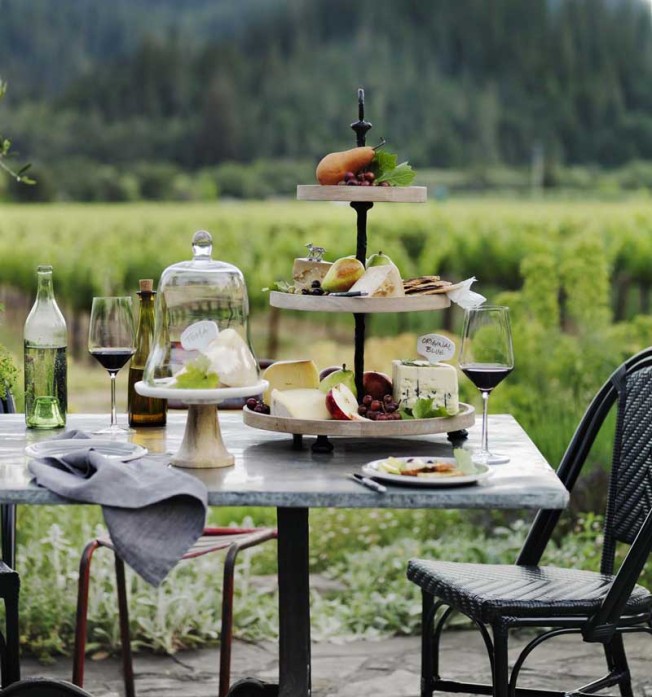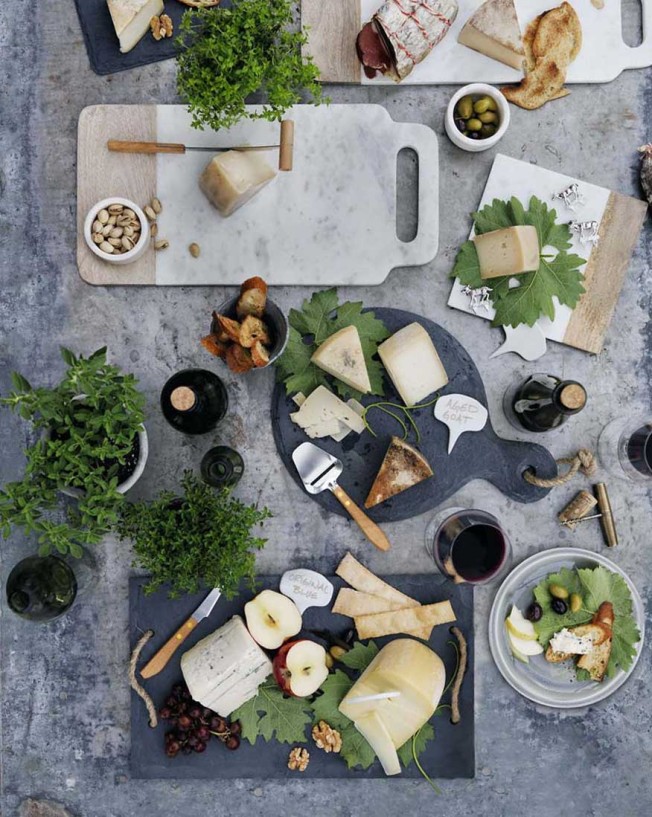No gathering is simpler — or more inviting — than a beautiful, bountiful spread of wine and cheese. It’s a great way to greet guests before a meal and also an easy entertaining idea on its own. Here, we’ll show you how to choose artisanal cheeses and wines that bring out the best in each selection.
Cheese
An assortment of a few different cheeses will give you variety without overwhelming guests. There are a few ways to create diversity: in cheese age or type (one bloomy rind, one semifirm, one blue); milk type (one cow’s milk, one goat’s milk, one sheep’s milk); country of origin (one French, one Spanish, one Italian); or even locale (three from California).
Ultimately, you’re aiming for a range of flavors of textures, from creamy and buttery to crumbly and salty, and a mix of shape and colors for visual interest. When in doubt, ask your cheesemonger for recommendations — they’re trained to help you select the perfect choices. Find more tips for the perfect cheese plate here.
Wine
If you’re showcasing cheeses from a specific region, it can be fun to serve wines from the same area for a true representation of the place (think California, Italy or France). In any case, pair the style of cheese with a wine that will highlight its flavors, whether that means matching or counterbalancing them. A citrusy Sauvignon Blanc can echo the tartness of a fresh chevre beautifully, but a sweet dessert wine can complement a salty blue cheese as well.
Consider these flavors: acidity or tartness, bitterness, sweetness, and spiciness. Consider whether a cheeses is smooth, creamy, crumbly, firm or hard and dry, then think about compatible qualities in your wine choice — crisp, dry, buttery, velvety or full-bodied. Age matters, too — younger, lighter wines will work best with younger milder cheeses, while long-aged cheeses need well-aged wines.
Here are some classic matches that work:
- Chevre & Sancerre: These two specialties of France’s Loire Valley are made for each other. The tangy, acidic flavors of fresh goat cheese is matched by the crisp, lively Sauvignon Blanc, and the wine’s herbaceous quality highlights the earthiness of the cheese.
- Double- or triple-cream cheeses & Champagne: Rich cheeses like Brillat-Savarin coat the mouth. The bubbles and subtle fruit of a sparkling wine refresh the palate but cutting through the creaminess, yet emphasizing its luxurious texture.
- Parmigiano-Reggiano & Sangiovese: Hard aged cheeses with a little bite tend to pair well with red wines, and Chianti and Brunello — both made from the Sangiovese grape — are produced in the same region as Parmigiano-Reggiano. These rich, medium- to full-bodied wines tame the sharpness of the cheese, and the pleasantly salty cheese brings out the ripe fruit notes in the wine.
- Stilton & port: English Stilton — a creamy blue with distinctive salty, nutty, meaty and smoky flavors — meets its match in vintage port, with its equally luscious mouthfeel, ripe flavors and full body. The sweetness of the wine counteracts the saltiness of the cheese, and the pairing makes each bite or sip more captivating.
Accompaniments
Choose accompaniments to match the cheese, season, and occasion. Offer bread (such as baguette slices) or crackers, as well as cured meats, which pair well with almost all cheeses, from hard aged to soft and fresh. We love a mix of fresh and dried fruits — think dried apricots, dates or figs, and slices of fresh apples and pears. Nuts deliver crunch and extra flavor, especially to softer cheeses, and olives are foolproof, too. Finally, look for preserves and spreads that will be delicious layered with cheese and crackers: jams, chutneys, compotes, pastes, honey, marmalades and tapenades.
If you’re serving many cheeses, try mixing and matching boards in different shapes, colors and textures for visual interest (we like this rounded slate one, a rectangular one, and a combination of wood and marble. Add decorative leaves for color.
Each cheese needs its own knife; that way flavors won’t mingle and you can appreciate the uniqueness of each one. Use a three-piece set for a variety of textures or spreaders for soft cheeses. It’s also a good idea to label cheeses so guests know which ones they have tasted (and which ones they like!) Write down the names on these ceramic markers — you can reuse them again and again.
As beautiful as cheese boards are, any table display benefits from some height. For visual interest, arrange fruit and cheese on a tiered stand, and place a glass cloche over some cheeses to keep them fresh.
Add pops of color to the table with bowls full of whole fruits. Place baguette slices upright in a cup or glass of an unexpected presentation. Potted plants also give the table a splash of vibrant green color; we like showing them in rustic, vintage-style containers.
Find everything you need in our Wine & Cheese shop!



1 comment
This post is full of excellent suggestions…Planning a wine-cheese is truly amzing idea to delight guests.I am soon planning to throw a party for my friends and I will consider all your suggestions for reference.